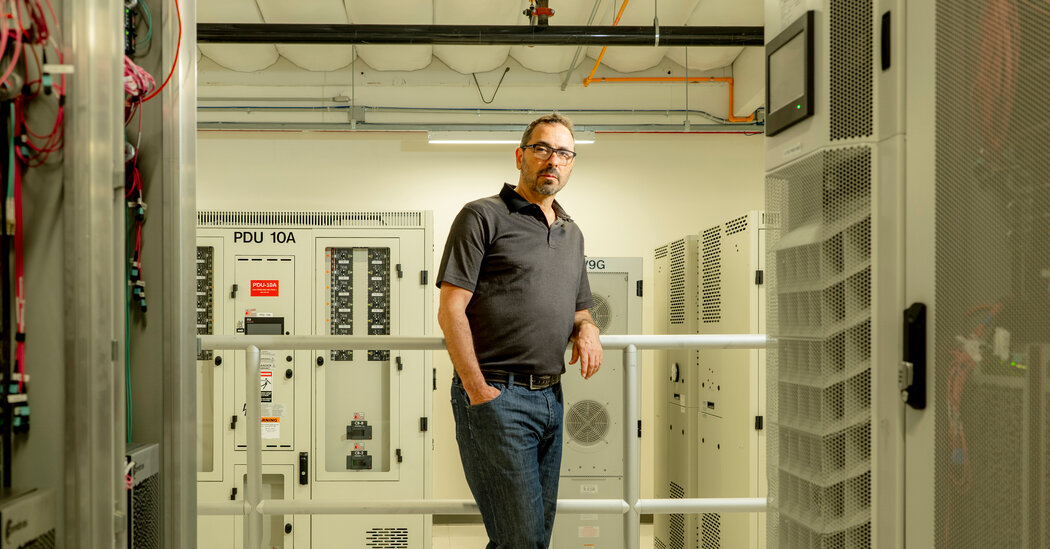In a cavernous room this week in a one-story building in Santa Clara, California, six-and-a-half-foot tall machines whirred behind white cabinets. The machines formed a new supercomputer that became operational last month.
Unveiled Thursday by Silicon Valley start-up Cerebras, the supercomputer is built with the company’s specialized chips designed to power artificial intelligence products. The chips are notable for their size – like that of a board, or 56 times the size of a chip commonly used for AI. Each Cerebras chip contains the computing power of hundreds of traditional chips.
Cerebras said it built the supercomputer for G42, an AI company. G42 said it planned to use the supercomputer to create and power AI products for the Middle East.
“What we’re showing here is that there’s an opportunity to build a very large, dedicated AI supercomputer,” said Andrew Feldman, Cerebras’ CEO. He added that his start-up wanted to “show the world that this work can be done faster, it can be done with less energy and it can be done at a lower cost.”
Demand for computing power and AI chips has skyrocketed this year, fueled by a global AI boom. Tech giants such as Microsoft, Meta, and Google, as well as countless start-ups, have been rushing to roll out AI products in recent months after the AI-powered ChatGPT chatbot went viral for the uncanny human prose it could generate.
But creating AI products typically requires significant amounts of computing power and specialized chips, leading to a ferocious hunt for more of those technologies. In May, Nvidia, the leading maker of chips used to power AI systems, said interest in its products — known as graphics processing units, or GPUs — was so great that quarterly sales were more than 50 percent above estimates. Wall Street would lie. The prediction pushed Nvidia’s market value above $1 trillion.
“For the first time, we are seeing a huge jump in computing requirements” due to AI technologies, said Ronen Dar, founder of Run:AI, a Tel Aviv startup that helps companies develop AI models. That has “created huge demand” for specialized chips, he added, and companies have “hurried to secure access to them.”
To get their hands on enough AI chips, some of the biggest tech companies — including Google, Amazon, Advanced Micro Devices, and Intel — have developed their own alternatives. Startups such as Cerebras, Graphcore, Groq, and SambaNova have also joined the race, aiming to break into the market that Nvidia dominates.
Chips will play such a key role in AI that they could change the balance of power between tech companies and even nations. For example, the Biden administration recently weighed restrictions on the sale of AI chips to China, with some US officials saying China’s AI capabilities could pose a national security threat to the United States by weakening the country’s military and security apparatus. to strengthen Beijing.
AI supercomputers have been built before, including by Nvidia. But it’s rare for startups to create them.
Based in Sunnyvale, California, Cerebras was founded in 2016 by Mr. Feldman and four other engineers, with the goal of building hardware that accelerates the development of AI. Over the years, the company has raised $740 million, including from Sam Altman, who runs the AI lab OpenAI, and venture capital firms such as Benchmark. Cerebras is valued at $4.1 billion.
Because the chips typically used to power AI are small — often the size of a postage stamp — it takes hundreds or even thousands to process a complicated AI model. In 2019, Cerebras unveiled what it claims was the largest computer chip ever, and Mr Feldman has said its chips can train AI systems between 100 and 1000 times faster than existing hardware.
G42, the Abu Dhabi company, started working with Cerebras in 2021. It used a Cerebras system to train an Arabic version of ChatGPT in April.
In May, G42 asked Cerebras to build a network of supercomputers in different parts of the world. Talal Al Kaissi, the CEO of G42 Cloud, a subsidiary of G42, said the advanced technology would enable his company to create chatbots and use AI to analyze genomic and preventive care data.
But the demand for GPUs was so great that it was difficult to get enough to build a supercomputer. Cerebras’ technology was both available and cost-effective, said Mr. Al Kaisi. So Cerebras used its chips to build the supercomputer for G42 in just 10 days, Mr. Feldman said.
“The time scale has been greatly shortened,” said Mr Al Kaissi.
Over the next year, Cerebras said, it plans to build two more supercomputers for G42 — one in Texas and one in North Carolina — and then six more around the world. It calls this network Condor Galaxy.
Startups will nevertheless likely find it difficult to compete with Nvidia, said Chris Manning, a computer scientist at Stanford whose research focuses on AI. .
Other start-ups have also tried to enter the AI chip market, but many have “effectively failed,” said Dr. Manning.
But Mr. Feldman said he was hopeful. Many AI companies don’t want to just be tied to Nvidia, he said, and there’s global demand for other high-performance chips like those from Cerebras.
“We hope this will help AI move forward,” he said.

